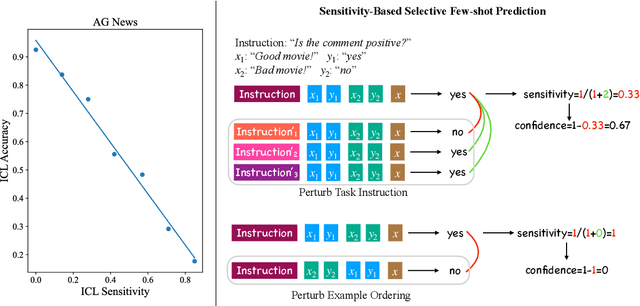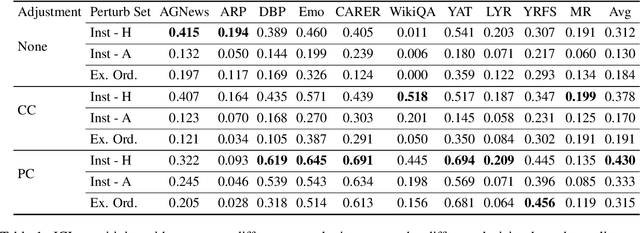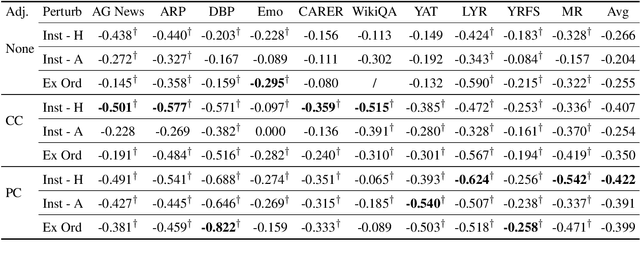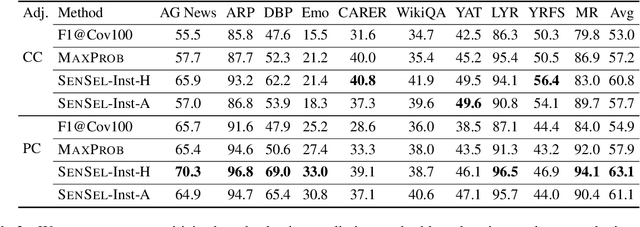Yanda Chen
Department of Computer Science, Columbia University
CTR-Driven Ad Text Generation via Online Feedback Preference Optimization
Jul 27, 2025Abstract:Advertising text plays a critical role in determining click-through rates (CTR) in online advertising. Large Language Models (LLMs) offer significant efficiency advantages over manual ad text creation. However, LLM-generated ad texts do not guarantee higher CTR performance compared to human-crafted texts, revealing a gap between generation quality and online performance of ad texts. In this work, we propose a novel ad text generation method which optimizes for CTR through preference optimization from online feedback. Our approach adopts an innovative two-stage framework: (1) diverse ad text sampling via one-shot in-context learning, using retrieval-augmented generation (RAG) to provide exemplars with chain-of-thought (CoT) reasoning; (2) CTR-driven preference optimization from online feedback, which weighs preference pairs according to their CTR gains and confidence levels. Through our method, the resulting model enables end-to-end generation of high-CTR ad texts. Extensive experiments have demonstrated the effectiveness of our method in both offline and online metrics. Notably, we have applied our method on a large-scale online shopping platform and achieved significant CTR improvements, showcasing its strong applicability and effectiveness in advertising systems.
Counterfactual Simulatability of LLM Explanations for Generation Tasks
May 27, 2025Abstract:LLMs can be unpredictable, as even slight alterations to the prompt can cause the output to change in unexpected ways. Thus, the ability of models to accurately explain their behavior is critical, especially in high-stakes settings. One approach for evaluating explanations is counterfactual simulatability, how well an explanation allows users to infer the model's output on related counterfactuals. Counterfactual simulatability has been previously studied for yes/no question answering tasks. We provide a general framework for extending this method to generation tasks, using news summarization and medical suggestion as example use cases. We find that while LLM explanations do enable users to better predict LLM outputs on counterfactuals in the summarization setting, there is significant room for improvement for medical suggestion. Furthermore, our results suggest that the evaluation for counterfactual simulatability may be more appropriate for skill-based tasks as opposed to knowledge-based tasks.
Reasoning Models Don't Always Say What They Think
May 08, 2025Abstract:Chain-of-thought (CoT) offers a potential boon for AI safety as it allows monitoring a model's CoT to try to understand its intentions and reasoning processes. However, the effectiveness of such monitoring hinges on CoTs faithfully representing models' actual reasoning processes. We evaluate CoT faithfulness of state-of-the-art reasoning models across 6 reasoning hints presented in the prompts and find: (1) for most settings and models tested, CoTs reveal their usage of hints in at least 1% of examples where they use the hint, but the reveal rate is often below 20%, (2) outcome-based reinforcement learning initially improves faithfulness but plateaus without saturating, and (3) when reinforcement learning increases how frequently hints are used (reward hacking), the propensity to verbalize them does not increase, even without training against a CoT monitor. These results suggest that CoT monitoring is a promising way of noticing undesired behaviors during training and evaluations, but that it is not sufficient to rule them out. They also suggest that in settings like ours where CoT reasoning is not necessary, test-time monitoring of CoTs is unlikely to reliably catch rare and catastrophic unexpected behaviors.
Curriculum Coarse-to-Fine Selection for High-IPC Dataset Distillation
Mar 24, 2025Abstract:Dataset distillation (DD) excels in synthesizing a small number of images per class (IPC) but struggles to maintain its effectiveness in high-IPC settings. Recent works on dataset distillation demonstrate that combining distilled and real data can mitigate the effectiveness decay. However, our analysis of the combination paradigm reveals that the current one-shot and independent selection mechanism induces an incompatibility issue between distilled and real images. To address this issue, we introduce a novel curriculum coarse-to-fine selection (CCFS) method for efficient high-IPC dataset distillation. CCFS employs a curriculum selection framework for real data selection, where we leverage a coarse-to-fine strategy to select appropriate real data based on the current synthetic dataset in each curriculum. Extensive experiments validate CCFS, surpassing the state-of-the-art by +6.6\% on CIFAR-10, +5.8\% on CIFAR-100, and +3.4\% on Tiny-ImageNet under high-IPC settings. Notably, CCFS achieves 60.2\% test accuracy on ResNet-18 with a 20\% compression ratio of Tiny-ImageNet, closely matching full-dataset training with only 0.3\% degradation. Code: https://github.com/CYDaaa30/CCFS.
Social Orientation: A New Feature for Dialogue Analysis
Feb 26, 2024



Abstract:There are many settings where it is useful to predict and explain the success or failure of a dialogue. Circumplex theory from psychology models the social orientations (e.g., Warm-Agreeable, Arrogant-Calculating) of conversation participants and can be used to predict and explain the outcome of social interactions. Our work is novel in its systematic application of social orientation tags to modeling conversation outcomes. In this paper, we introduce a new data set of dialogue utterances machine-labeled with social orientation tags. We show that social orientation tags improve task performance, especially in low-resource settings, on both English and Chinese language benchmarks. We also demonstrate how social orientation tags help explain the outcomes of social interactions when used in neural models. Based on these results showing the utility of social orientation tags for dialogue outcome prediction tasks, we release our data sets, code, and models that are fine-tuned to predict social orientation tags on dialogue utterances.
Parallel Structures in Pre-training Data Yield In-Context Learning
Feb 19, 2024Abstract:Pre-trained language models (LMs) are capable of in-context learning (ICL): they can adapt to a task with only a few examples given in the prompt without any parameter update. However, it is unclear where this capability comes from as there is a stark distribution shift between pre-training text and ICL prompts. In this work, we study what patterns of the pre-training data contribute to ICL. We find that LMs' ICL ability depends on $\textit{parallel structures}$ in the pre-training data -- pairs of phrases following similar templates in the same context window. Specifically, we detect parallel structures by checking whether training on one phrase improves prediction of the other, and conduct ablation experiments to study their effect on ICL. We show that removing parallel structures in the pre-training data reduces LMs' ICL accuracy by 51% (vs 2% from random ablation). This drop persists even when excluding common patterns such as n-gram repetitions and long-range dependency, showing the diversity and generality of parallel structures. A closer look at the detected parallel structures indicates that they cover diverse linguistic tasks and span long distances in the data.
Towards Consistent Natural-Language Explanations via Explanation-Consistency Finetuning
Jan 25, 2024



Abstract:Large language models (LLMs) often generate convincing, fluent explanations. However, different from humans, they often generate inconsistent explanations on different inputs. For example, an LLM may generate the explanation "all birds can fly" when answering the question "Can sparrows fly?" but meanwhile answer "no" to the related question "Can penguins fly?". Explanations should be consistent across related examples so that they allow a human to simulate the LLM's decision process on multiple examples. We propose explanation-consistency finetuning (EC-finetuning), a method that adapts LLMs to generate more consistent natural-language explanations on related examples. EC-finetuning involves finetuning LLMs on synthetic data that is carefully constructed to contain consistent explanations. Across a variety of question-answering datasets in various domains, EC-finetuning yields a 10.0% relative explanation consistency improvement on four finetuning datasets, and generalizes to seven out-of-distribution datasets not seen during finetuning (+4.5% relative). Code is available at https://github.com/yandachen/explanation-consistency-finetuning .
Do Models Explain Themselves? Counterfactual Simulatability of Natural Language Explanations
Jul 17, 2023Abstract:Large language models (LLMs) are trained to imitate humans to explain human decisions. However, do LLMs explain themselves? Can they help humans build mental models of how LLMs process different inputs? To answer these questions, we propose to evaluate $\textbf{counterfactual simulatability}$ of natural language explanations: whether an explanation can enable humans to precisely infer the model's outputs on diverse counterfactuals of the explained input. For example, if a model answers "yes" to the input question "Can eagles fly?" with the explanation "all birds can fly", then humans would infer from the explanation that it would also answer "yes" to the counterfactual input "Can penguins fly?". If the explanation is precise, then the model's answer should match humans' expectations. We implemented two metrics based on counterfactual simulatability: precision and generality. We generated diverse counterfactuals automatically using LLMs. We then used these metrics to evaluate state-of-the-art LLMs (e.g., GPT-4) on two tasks: multi-hop factual reasoning and reward modeling. We found that LLM's explanations have low precision and that precision does not correlate with plausibility. Therefore, naively optimizing human approvals (e.g., RLHF) may not be a sufficient solution.
In-context Learning Distillation: Transferring Few-shot Learning Ability of Pre-trained Language Models
Dec 20, 2022Abstract:Given the success with in-context learning of large pre-trained language models, we introduce in-context learning distillation to transfer in-context few-shot learning ability from large models to smaller models. We propose to combine in-context learning objectives with language modeling objectives to distill both the ability to read in-context examples and task knowledge to the smaller models. We perform in-context learning distillation under two different few-shot learning paradigms: Meta In-context Tuning (Meta-ICT) and Multitask In-context Tuning (Multitask-ICT). Multitask-ICT performs better on multitask few-shot learning but also requires more computation than Meta-ICT. Our method shows consistent improvements for both Meta-ICT and Multitask-ICT on two benchmarks: LAMA and CrossFit. Our extensive experiments and analysis reveal that in-context learning objectives and language modeling objectives are complementary under the Multitask-ICT paradigm. In-context learning objectives achieve the best performance when combined with language modeling objectives.
On the Relation between Sensitivity and Accuracy in In-context Learning
Sep 16, 2022



Abstract:In-context learning (ICL) suffers from oversensitivity to the prompt, which makes it unreliable in real-world scenarios. We study the sensitivity of ICL with respect to multiple types of perturbations. First, we find that label bias obscures true ICL sensitivity, and hence prior work may have significantly underestimated the true ICL sensitivity. Second, we observe a strong negative correlation between ICL sensitivity and accuracy, with sensitive predictions less likely to be correct. Motivated by these observations, we propose \textsc{SenSel}, a few-shot selective prediction method based on ICL sensitivity. Experiments on ten classification benchmarks show that \textsc{SenSel} consistently outperforms a commonly used confidence-based selective prediction baseline.
 Add to Chrome
Add to Chrome Add to Firefox
Add to Firefox Add to Edge
Add to Edge